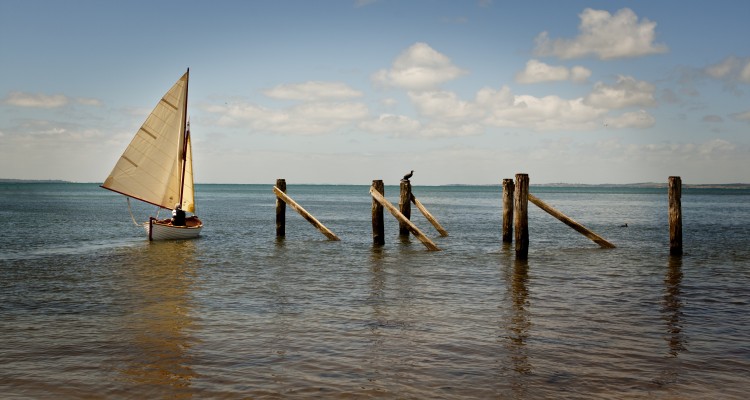Was it Mahatma Gandhi that once said “Where there’s love, there’s life.” This story involves both – a century to be exact. The sturdy little boat photographed in this story is known as Trim, who’s spent the first half century of her life criss–crossing Tasmania’s Derwent River and Melbourne’s Hobson’s Bay – but rarely getting wet. The 15ft double–ender spent 50 years sitting under canvas on the deck of the steam ferry Rosny, before a troop of Sea Scouts launched her into a new career in the 1960s as a training craft.
These days classic workboats are an endangered species, but this Tasmanian led a fortunate life. She managed to remain remarkably intact for one hundred years and has now been restored by Russell Kenery, an avid enthusiast who appreciates a great gal when he sees one (heritage, elegance and seaworthiness). Given she had no recorded name, Russell christened her Trim, after Pacific navigator Mathew Flinders’ seafaring cat. Why? Because only four letters fit the roundels on her bow – Russell has a great knowledge of maritime history and a great sense of humour – which we love.
Trim (the cat) was born in 1799, aboard the ship Roundabout on a voyage from the Cape of Good Hope to Botany Bay. The kitten fell overboard, but managed to swim back to the vessel and climb aboard by scaling a rope; taking note of his strong survival instinct and intelligence, Flinders and his crew made him their favourite. Matthew Flinders once wrote in memory of his cat –
The best and most illustrious of his race, the most affectionate of friends, faithful of servants, and best of creatures. He made the tour of the globe, and voyage to Australia, which he circumnavigated, and was ever the delight and pleasure of his fellow voyagers.
Back to our story – it was 1913, just before the advent of compact petrol engines, when Trim was built. She is a rare link to the twilight years of working sailboats and rowing boats. Small utility workboats were the primary means of transportation on Tasmanian in-shore waters from about 1810, delivering people and goods from point to point, from ship to shore and also as lifeboats. Their design form followed function and the practical arrangement of oars and sailing rig also happened to be graceful and attractive. The boat builders may not have thought of their work as an art form, but they certainly had a discerning eye for beauty.
For those who appreciate the finer specs, Trim’s construction is in Huon pine – clinker-build with gunwales nearly straight from bow to stern. A proportion of 2.7 beams to length give seaworthiness, good carrying power and fair speed. The hull has a flat shallow-draft for pulling up on shore and the barn-door rudder can be raised in–line with the keel. Three thwarts can accommodate four oarsmen, two off-set. She’s efficient under oar and the double-ender design makes her manoeuvrable. Beyond being a classic rowing boat, she adopts well to sail under her small Gunter sailing rig with stem mounted headsail and centre dagger-board.
Trim received two special presents for her 100th birthday in 2013. One, a new suit of sails crafted in traditional 18 inch panels in keeping with her era, the other, acceptance onto the Australian Register of Historic Vessels following assessment by the Australian National Maritime Museum on criteria such as significance, completeness, provenance and rarity. Well done Trim, well done Russell. We look forward to seeing you on the Pen for many years to come. Hip, hip, hooray to Trim and you from scoop and the LTP team.








Leave a Reply
You must be logged in to post a comment.